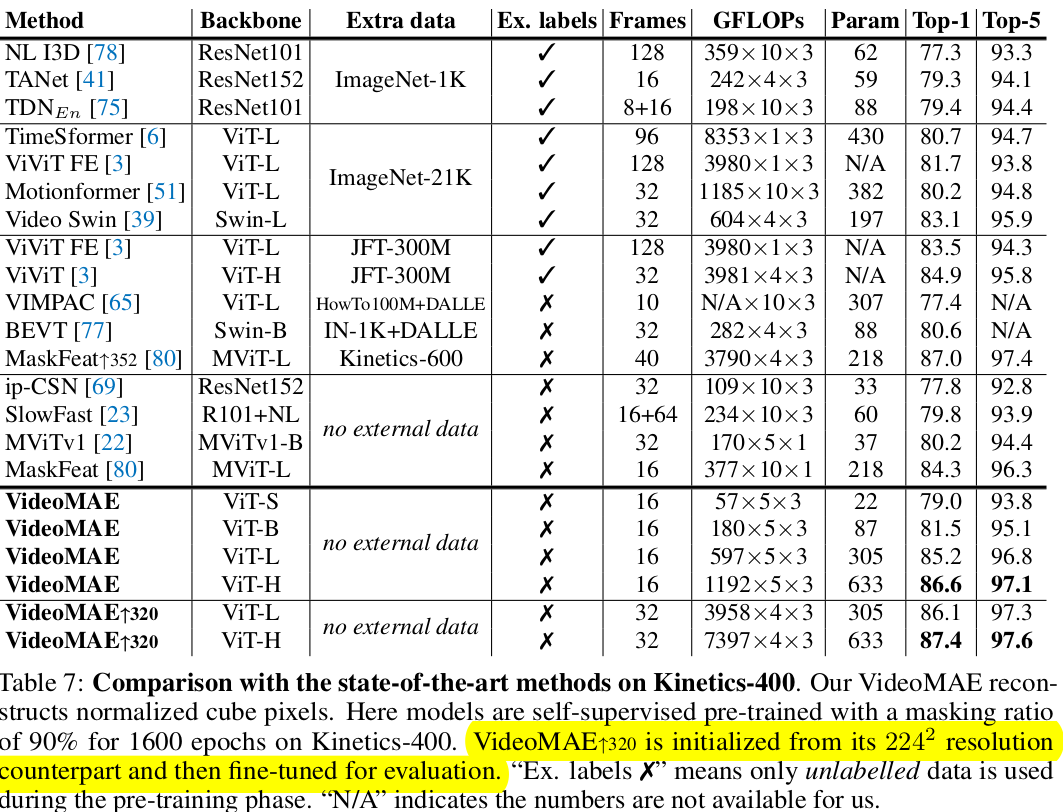[SSL2][AR] VideoMAE: Masked Autoencoders are Data-Efficient Learners for Self-Supervised Video Pre-Training
[SSL2][AR] VideoMAE: Masked Autoencoders are Data-Efficient Learners for Self-Supervised Video Pre-Training
- paper: https://arxiv.org/pdf/2203.12602.pdf
- github: https://github.com/MCG-NJU/VideoMAE
- NeurIPS 2022 accpeted (Spot Light, 인용수: 537회, ‘24-03-27 기준)
- downstream task: Video action classification, Video action detection
1. Motivation
- Image domain에서 MAE 기반의 self-supervised learning로 학습한 representation이 매우 효과적인 것을 바탕으로 video domain에서도 이를 응용하고자 함
- Temporal dimension으로 redundunt한 video domain 특성을 살린 VideoMAE를 제안해보자!
2. Contribution
-
Simple하지만 effective하게 vanilla ViT를 활용할 수 있는 masked video autoencoder를 제안함
-
특징: extremely high masking ratio (90~95%) + temporally same masking (tube masking)

-
-
Self-Supervised Video Pretraining (SSVP) 분야에 제안한 VideoMAE가 다른 pre-trained 기법들 (random initalization, contrastive learning)보다 효과적임을 입증

-
기존까지 Masked Modeling에서 간과했던 점들을 추가 분석을 통해 발견함
-
VideoMAE는 Data-Efficient Learner임 (3.5K video만 사용해도 됨)
-
Data의 Quality가 Quantity보다 중요함 (Domain Shift관련 실험)
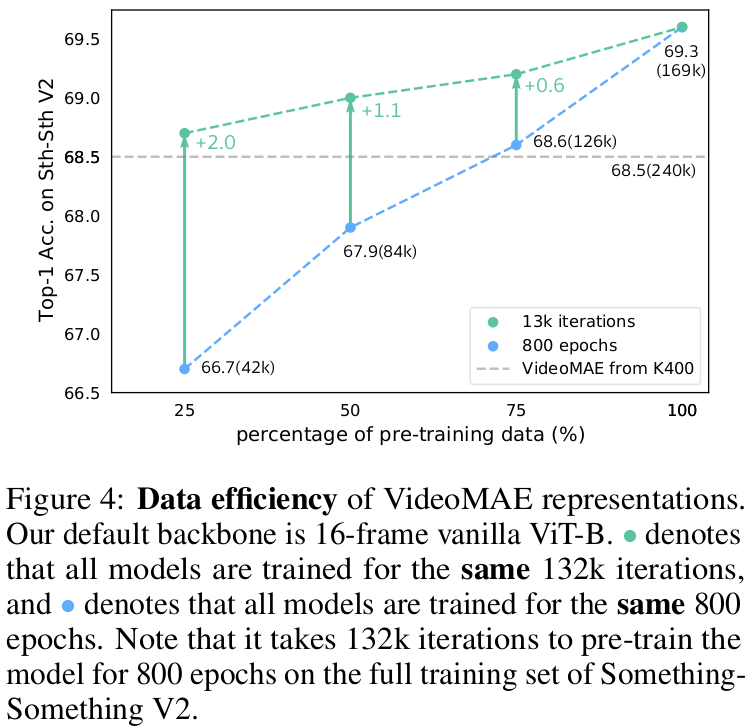
-
회색 점선: Kinetics-400으로 Pretrain하고, SSV2에 Fintuning한 결과
-
초록 점선: SSV2 100% pretrain한 iteration과 동일한 iteration으로 x%만 사용해서 pretrain하고, SSV2에 Fintuning한 결과
-
파란 점선: SSV2 100% pretrain한 epoch과 동일한 epoch으로 x%만 사용해서 pretrain하고, SSV2에 Fintuning한 결과
$\to$ 비록 훨씬 많은 데이터 (Kinetics-400)로 pretrain했다고 하더라도, domain shift가 있는 데이터로 SSVP한 경우보다 적은 양이지만 domain shift가 없는 (Preatrin data = Finetune data)에 Finetune결과가 좋음
-
-
3. VideoMAE
3.1 Revisiting Image Masked AutoEncoders
-
overall diagram
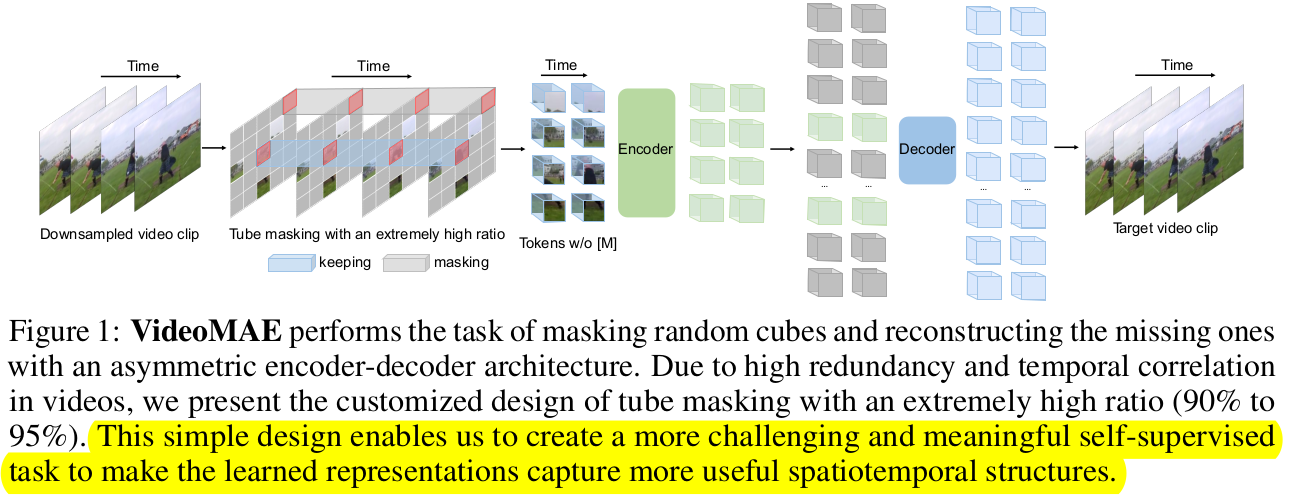
-
목적: masking한 이미지 영역을 나머지 영역만 가지고 reconstruction을 수행함으로써, high-level information (spatiotemporal reasoning over the content)를 학습

-
3.2 Characters of Video Data
-
Temporal redundancy
- Temporal dimension으로 semantic의 변화가 매우 느리게 나타남 $\to$ original temporal frame rate을 사용하는건 비효율적임
- NLP나 Image-vision에서 사용하는 50~75%의 normal masking ratio로 reconstruction을 수행하는 것은 어렵지 않아, motion에 대한 representation 학습을 약화시킴 $\to$ high masking ratio 제안
-
Temporal correlation
-
인접한 frame간의 내재적인 correspondence가 존재하는 것을 Temporal correlation이라고 함
-
plain한 random masking이나 frame masking(frame 통째로 masking)하는 것)만 가지고는 high-level spatiotemporal reasoning over content보다 low-level temporal correspondence를 학습하게됨 $\to$ tube masking방식 제안
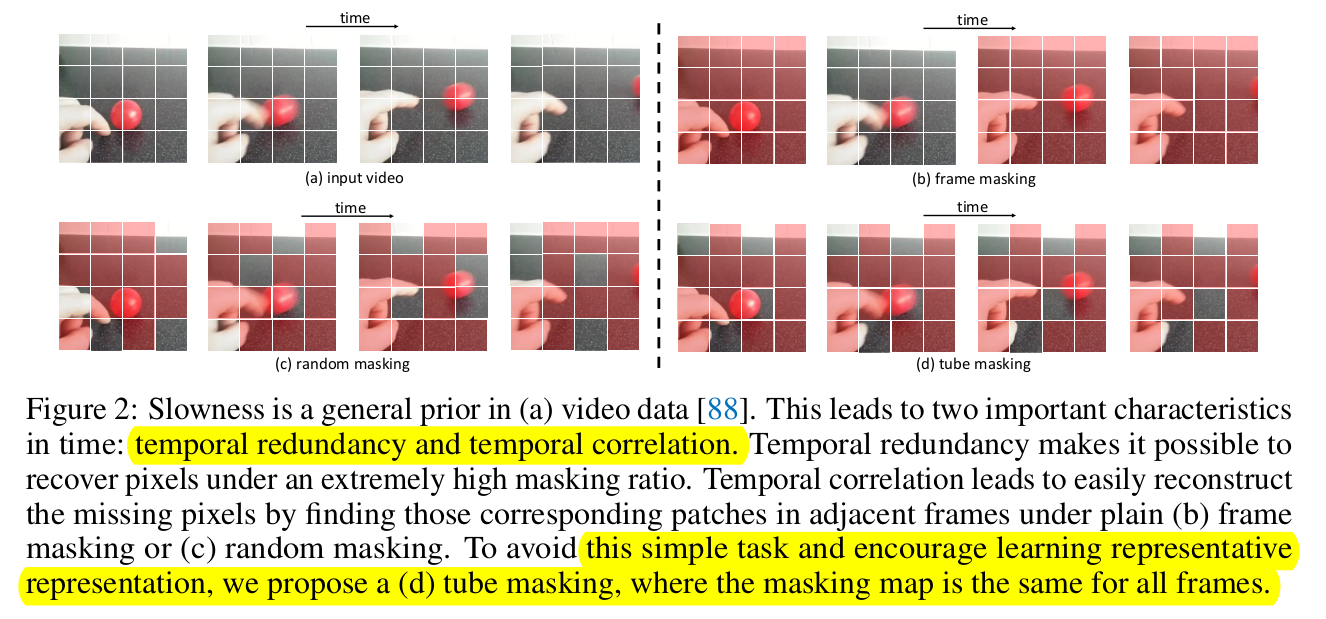
-
3.3 Video MAE
Temporal downsampling
- strided temporal sampling 기법 사용
- dataset마다 다른 stride 사용 $\tau =2, 4$
Cube embedding
- 2x16x16개의 token embedding을 cube로 정의 $\to \frac{T}{2} \times \frac{H}{16} \times \frac{W}{16}$ 의 cube embedding이 생성
- $\frac{T}{2} \times \frac{H}{16} \times \frac{W}{16} \to D$ dimension의 mapping을 학습
- 차원 축소된 만큼 video 내 spatiotemporal redundancy를 감소시키게 됨
Tube masking with extremely high ratios
- Video의 information density는 image보다 낮으므로, high masking ratios (90% or 95%)을 적용하는게 key factor
- Temporal correlation을 고려하여 Temporal dimension으로 tube masking을 수행하는 것이 high-level semantic을 향상시킬 수 있음
Backbone: joint space-time attention
-
Vanilla ViT backbone을 사용한 joint space-time attention을 학습하여 high-level spatiotemporal information을 remaining token을 가지고 학습함
-
masking된 영역은 제외한 나머지 영역만 encoder 입력으로 들어가 Self-attention 수행 $\to$ x10배의 computation efficient함
-
light-decoder의 입력으로 masking 영역에 learnable-mask token과 함께 enocder의 출력을 가지고 reconstruction 수행 $\to$ light하므로 efficient함
-
shallow decoder layer를 사용함 (4개 block)
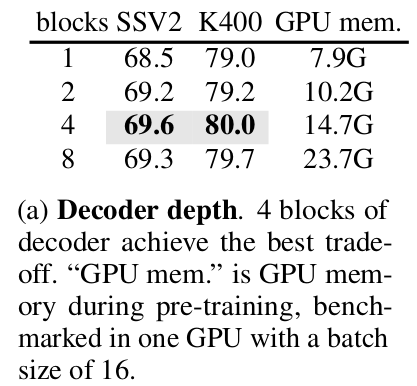
-
4. Experiments
-
ablation:
- (a) Decoder block 수, (b) masking ratio & 방식 (c) target frame sampling방식 (center=현 frame만 사용) (d) Pre-training 방식 (e) Pretraining dataset (f) Loss
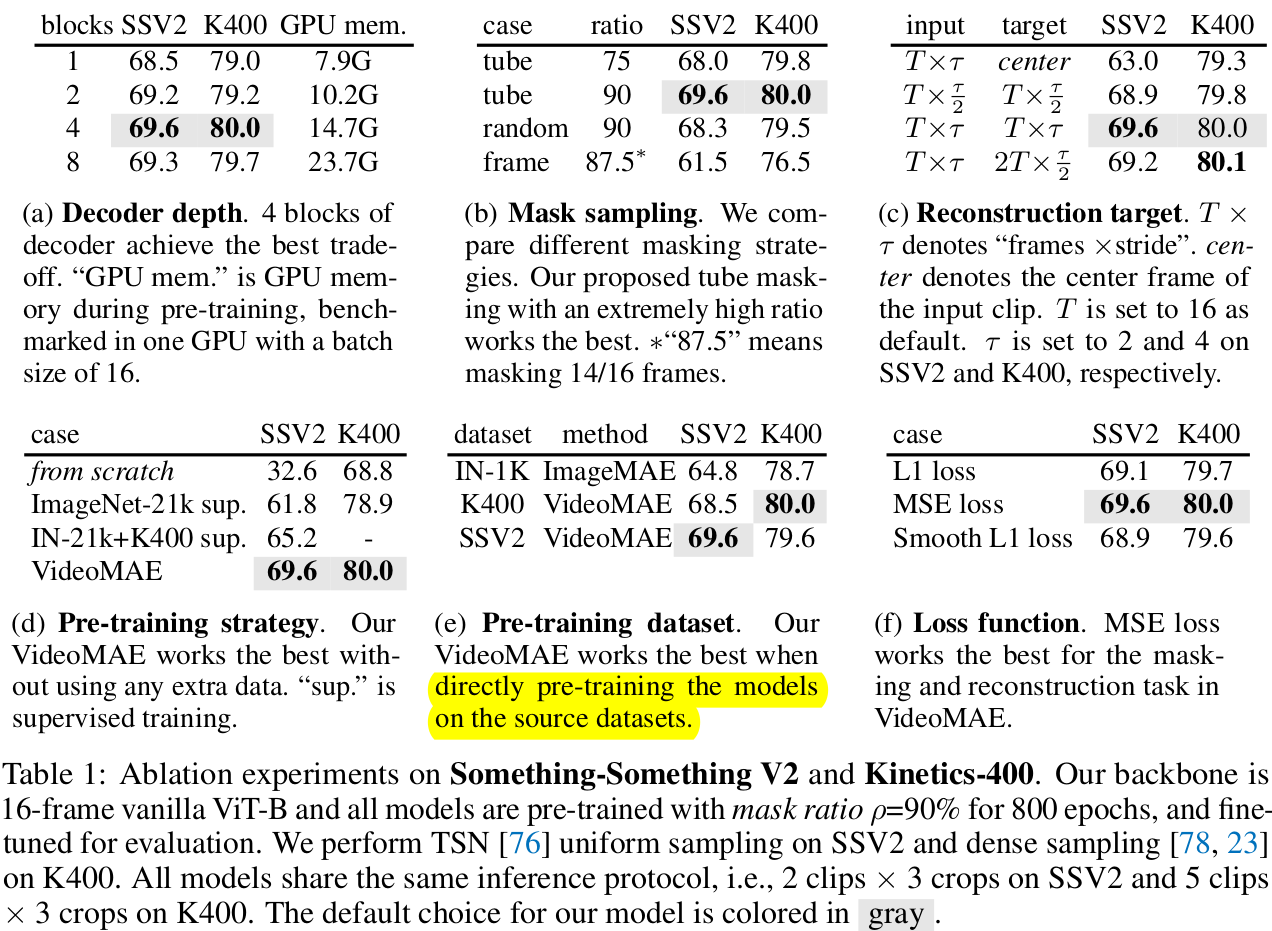
-
Pretraining 방식에 따른 성능 비교

- Table 2: Pretrained dataset과 Fine tuning dataset 동일
- Table 3: Pretraining 시 학습에 걸린 epoch 수, walltime
- Table 4: Pretraining을 큰 데이터 (K400)으로 하고, Fintuning을 작은 데이터 (SSV2, UCF, HMDB)에 한 결과.
- SSV2는 상대적으로 데이터셋도 많고, temporal related된 특성으로, K400으로 학습한것이 그렇지 않은것 (Table 2)보다 성능하락 발생
- 나머지는 데이터 셋 양이 워낙 적어, K400 pretraining한게 성능 향상에 긍정적임
-
Masking ratio
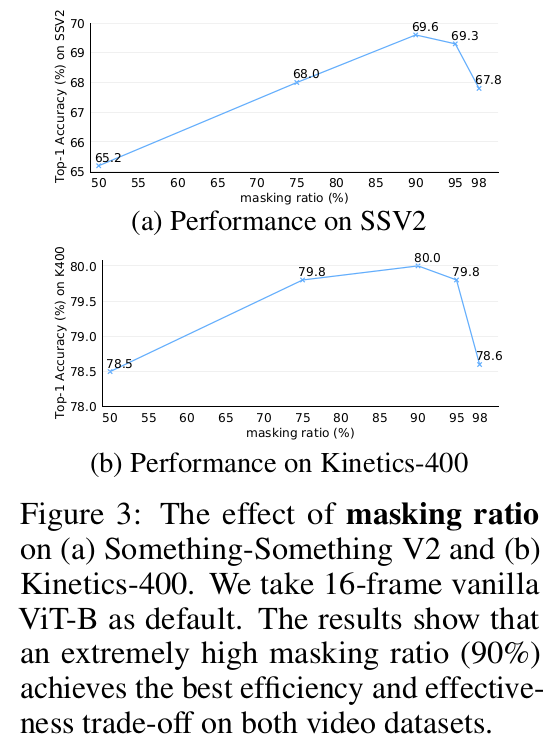
-
Pretrain Quantity vs Quality (Intro에서 언급)

-
Downstream Task : Video Detection (Transfer Learning) 적용 실험
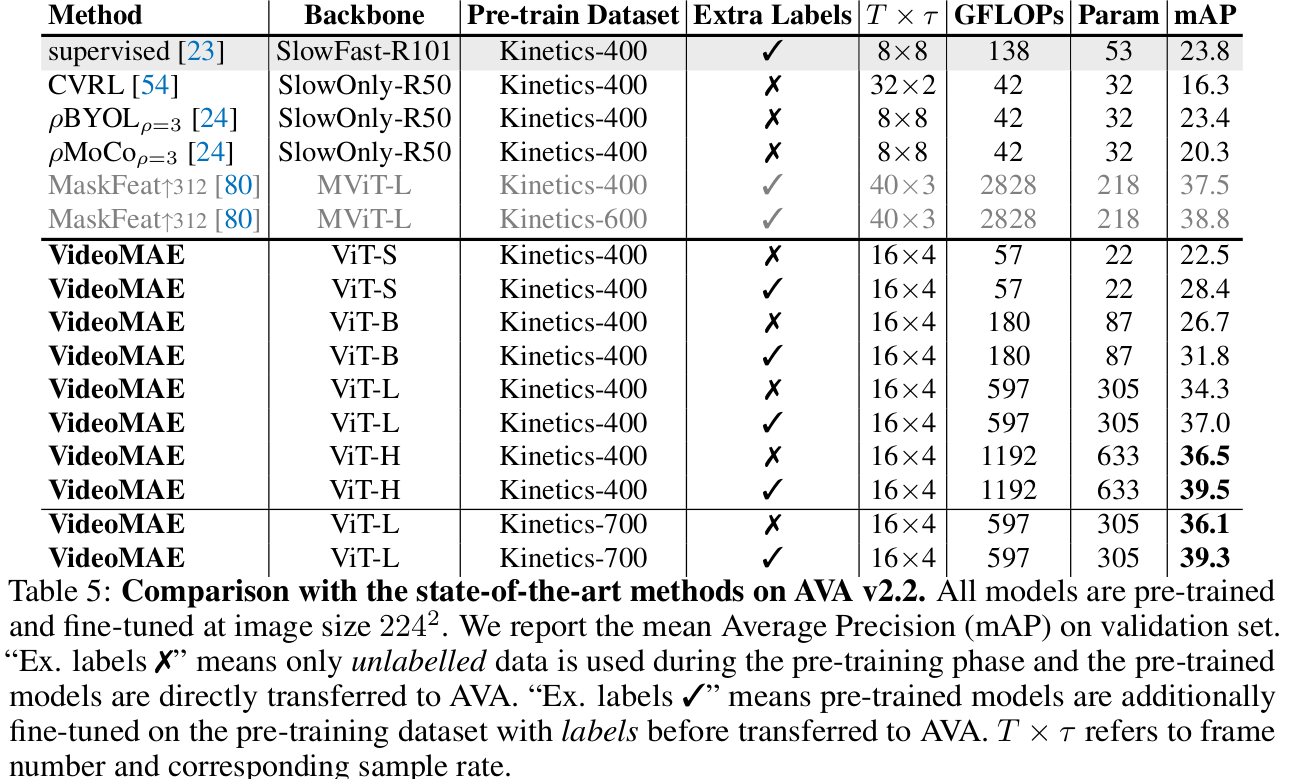
-
Something-to-Something V2
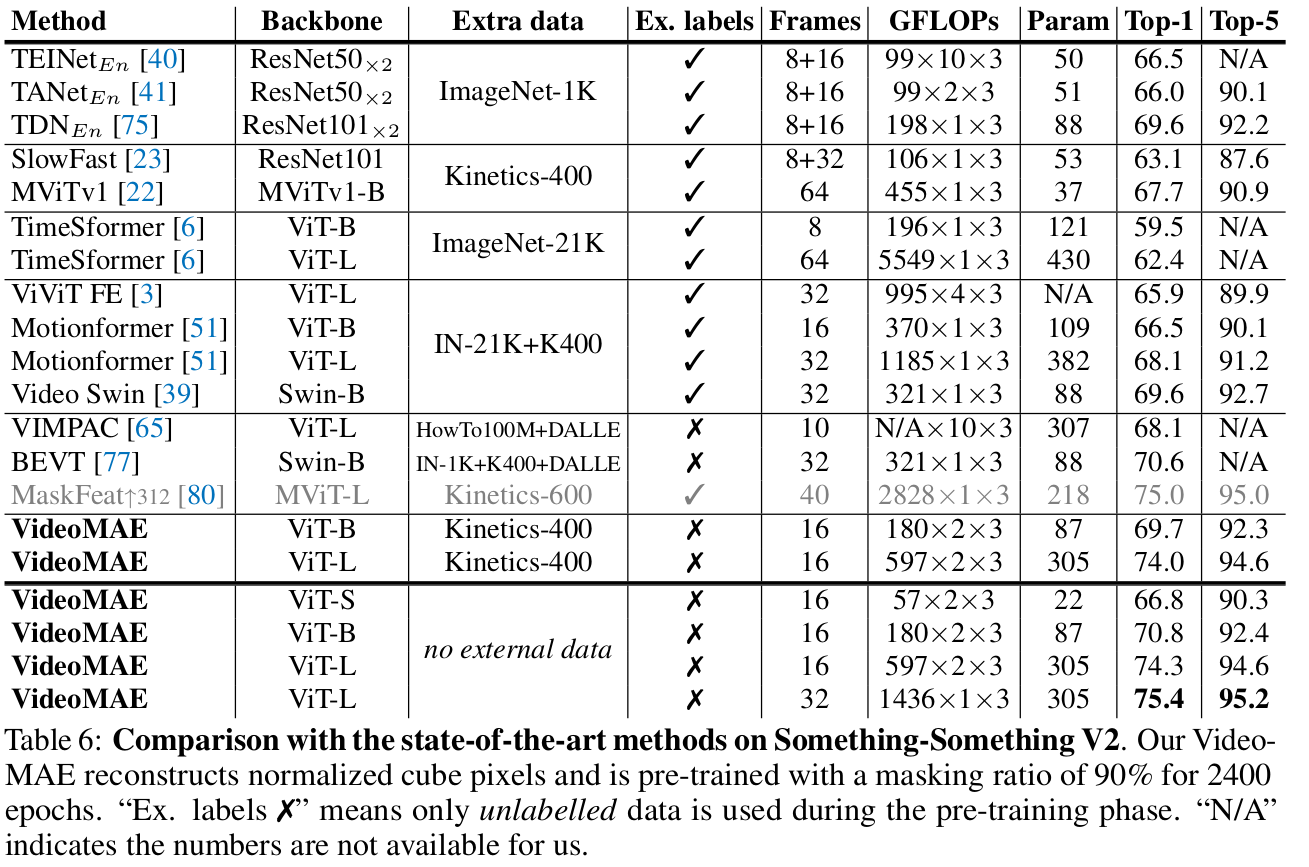
-
K400
